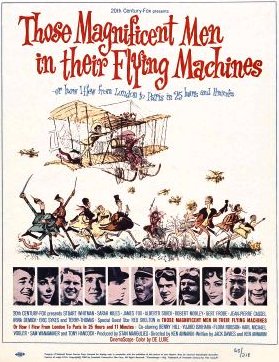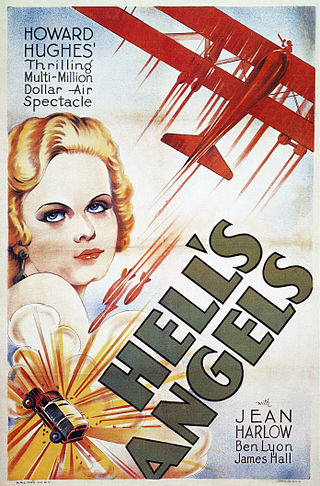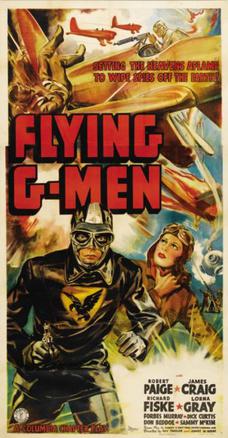Related Research Articles

General aviation (GA) is defined by the International Civil Aviation Organization (ICAO) as all civil aviation aircraft operations except for commercial air transport or aerial work, which is defined as specialized aviation services for other purposes. However, for statistical purposes, ICAO uses a definition of general aviation which includes aerial work.

Scottish Television is the ITV network franchisee for Central Scotland. The channel — the largest of the three ITV franchises in Scotland — has been in operation since 31 August 1957 and is the second-oldest franchise holder in the UK that is still active.

Those Magnificent Men in their Flying Machines or How I Flew from London to Paris in 25 Hours and 11 Minutes is a 1965 British epic period comedy film that satirises the early years of aviation. Directed and co-written by Ken Annakin, the film stars an international ensemble cast, including Stuart Whitman, Sarah Miles, Robert Morley, Terry-Thomas, James Fox, Red Skelton, Benny Hill, Jean-Pierre Cassel, Gert Fröbe and Alberto Sordi.

The Archie Show is an American musical animated sitcom television series produced by Filmation for CBS. Based on the Archie Comics, created by Bob Montana in 1941, The Archie Show aired Saturday mornings on CBS from September 1968 to 1969. The show featured the main characters in the Archie series, including Archie Andrews, Jughead Jones, Reggie Mantle, Betty Cooper and Veronica Lodge.

Albert Paul Mantz was a noted air racing pilot, movie stunt pilot and consultant from the late 1930s until his death in the mid-1960s. He gained fame on two stages: Hollywood and in air races.

Hell's Angels is a 1930 American pre-Code independent epic war film directed and produced by Howard Hughes and director of dialogue James Whale. Written by Harry Behn and Howard Estabrook and starring Ben Lyon, James Hall and Jean Harlow, it was released through United Artists. It follows two dissimilar brothers, both members of the British Royal Flying Corps during the First World War.

The Great Waldo Pepper is a 1975 American drama film directed, produced, and co-written by George Roy Hill. Set during 1926–1931, the film stars Robert Redford as a disaffected World War I veteran pilot who missed the opportunity to fly in combat, and examines his sense of postwar dislocation in 1920s America. The cast includes Margot Kidder, Bo Svenson, Edward Herrmann and Susan Sarandon. The Great Waldo Pepper depicts barnstorming during the 1920s and the accidents that led to aviation regulations by the Air Commerce Act.

Yoram Jerzy Gross was a Polish-born, Australian film and television producer, animation director, and writer of children's and family entertainment. He founded the animation studio Flying Bark Productions.
Gerald Bertram Fairbanks was a producer and director in the Hollywood motion picture and television industry.

Desiree Tyler Horton, nicknamed "Chopper Chick," is a helicopter pilot and television personality based in Los Angeles, California.

Reaching for the Skies was an aviation documentary TV series made by BBC Pebble Mill in association with CBS Fox. The first episode was transmitted in the United Kingdom on 12 September 1988 and in the US in 1989.
Craig B. Fisher was an American network and cable television producer. He spent more than 25 years with ABC, CBS, and NBC News Division in New York and Washington, D.C., and more than two decades as a freelance writer and producer. Fisher was responsible for over one thousand hours of live, film and videotape, studio and location television and corporate productions.

Flying G-Men is a 15-episode 1939 adventure film Film serial, directed by James W. Horne and Ray Taylor. The serial was the sixth of the 57 serials released by Columbia. Four "Flying G-Men" battle with enemy saboteurs intent on destroying American military defences.

A television show, TV program, or simply a TV show, is the general reference to any content produced for viewing on a television set that is traditionally broadcast via over-the-air, satellite, or cable. This includes content made by television broadcasters and content made for broadcasting by film production companies. It excludes breaking news, advertisements, or trailers that are typically placed between shows. Television shows are most often scheduled for broadcast well ahead of time and appear on electronic guides or other TV listings, but streaming services often make them available for viewing anytime. The content in a television show is produced by one of two production methodologies: live taped shows such as variety and news magazine shows shot on a television studio stage or sporting events The other production model includes animation and a variety of film productions ranging from movies to series. Shows not produced on a television studio stage are usually contracted or licensed to be made by appropriate production companies.

Dive Bomber is a 1941 American aviation drama film directed by Michael Curtiz, and starring Errol Flynn, Fred MacMurray and Alexis Smith. It was produced and distributed by Warner Brothers. The film is notable for both its Technicolor photography of pre-World War II United States Navy aircraft and as a historical document of the U.S. in 1941. This includes the aircraft carrier USS Enterprise, one of the best-known U.S. warships of World War II.
John D. Craig (1903–1997) was an American businessman, writer, soldier, diver, Hollywood stunt man, film producer, and television host. He worked in the commercial surface-supplied diving industry from the 1930s on, and filmed aerial combat over Europe during World War II. He is best known for using film and television to show the United States public the beauties and dangers of Earth's underwater worlds.
Craig Tanner is an American film director, film producer, and editor. He is best known for his work as visual effects editor for the film Avatar and as producer and editor of God Sleeps in Rwanda. Tanner is also the co-founder of Digital Revolution Studios, a 3D production studio.

Christopher Calvin Harrison is an American director, dancer, acrobat, choreographer, fitness professional, and founder of performance troupe AntiGravity, Inc. and its spin-off fitness brand, AntiGravity Fitness.
Kim Planert is a German film and television composer based in Los Angeles. He has composed music for over 230 episodes of prime-time television shows and feature films. His collection of TV credits include: eight seasons on the score for ABC's television show, Castle, Timeless (NBC), Missing (ABC), The Whispers, The McKenna Files, The Unit (CBS), Lie To Me(FOX), The Gates (ABC), The Chicago Code (FOX), Last Resort (ABC) and Rush

Raggs is a live-action/animated television series for children about five dogs that form a Ragtime band called The Raggs Band. There are 196 half hour episodes and 200 original songs in multiple languages. It was originally produced in Sydney, Australia, with additional production in the United States in English and Spanish. It was first broadcast in Australia on the Seven Network on January 2, 2006. In 2014, The Raggs Band reunited to record 20 classic kid's songs.
References
- ↑ Issacs, James (March 22, 1977). "Cellars by Starlight". The Boston Phoenix . Vol. 6, no. 12. p. 4.
- ↑ Hubler, Eric (April 12, 1998). "Vicarious Consumption: Making Short Work of Long Commutes". The New York Times . Retrieved February 10, 2008.
- ↑ Edwards, Nicole (December 13, 2002). "Red Hook photographer's work presents views from on high". Poughkeepsie Journal . p. 17.